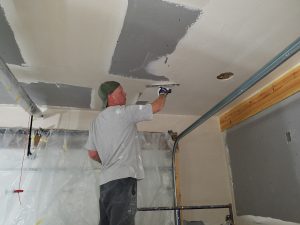 When applying a finish to a wall, many people do not consider how the application might impact the final product. The materials used could have significant issues down the road, and the improper application of those materials could require repairs. When choosing the best materials for the job between dry lining or wet plaster, it is important to consider the pros and cons of each.
When applying a finish to a wall, many people do not consider how the application might impact the final product. The materials used could have significant issues down the road, and the improper application of those materials could require repairs. When choosing the best materials for the job between dry lining or wet plaster, it is important to consider the pros and cons of each.
Dry Lining
When most people think of plaster, they think of wet plaster applied to walls. However, dry lining is the act of hanging plasterboard on a wall, which circumvents the need for traditional plaster application and ensures a smooth, flat surface. By approaching things this way, the final product can be achieved faster, with fewer variables. This faster application can speed up project deadlines and might save a bit of money.
However, there are a few drawbacks. While dry lining is faster, it does not account for the variables of the wall. Surface imperfections and changes in elevation can impact the hanging of the boards and could lead to cracks down the road. Additions to the wall and fixings like heating or shelves could pose challenges with dry lining. Ultimately, the challenges of dry lining come down to flexibility.
The flexibility offered by dry lining is nothing to scoff at, but the drawbacks should also be considered when choosing between dry lining or wet plaster.
Wet Plaster
The usual plaster application is wet plaster. It requires a professional touch and a significant amount of layers to achieve, but the final product is incredibly durable. It can be shaped and formed to a particular wall, or developed into a unique design, depending on the project. It has a large amount of versatility which makes it an ideal choice for difficult walls, but it has the major drawback of time investment.
While wet plaster is durable, it can take days to dry, and depending on the project that could be unacceptable. The time the plaster takes to dry is somewhat dependent on the contractor applying it, but in some projects, there simply is no room to wait. However, the benefits of wet plaster, namely durability and flexibility, should be considered when choosing between the two.
Which is Better?
Is there an obvious choice between the two? Believe it or not, the cost of wet plaster or dry lining is nearly the same for materials. The real cost difference will come down to labor, and it will depend on the goals for the final project. If the final goal requires the installation of wet plaster, but speed is necessary, dry lining might need to be considered. The ultimate answer is that there is not much of a difference. It comes down to personal preference and the restrictions of the job, not the materials.
If you have to make a choice, consult a professional. We are here to help you decide what is best for your project, and we have the experience to back those suggestions. Plaster is a fantastic material that will protect your walls for decades, so it is worth making sure it is installed right.
